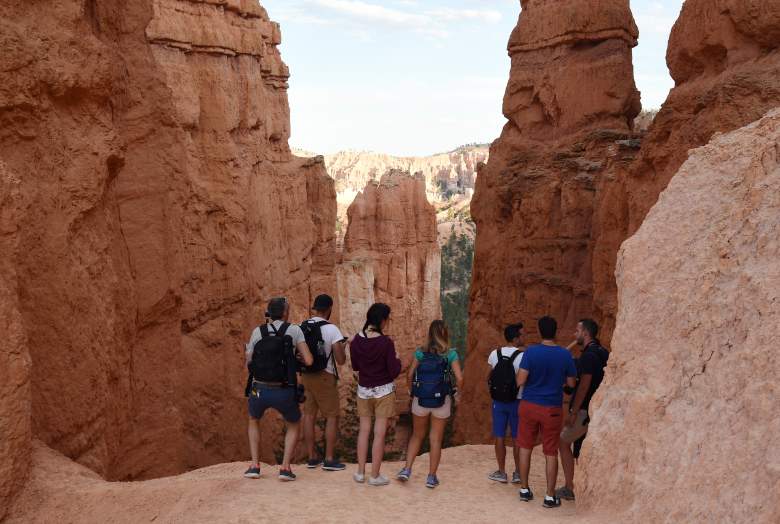
(Getty Images)
Today, March 30, marks National Take A Walk In The Park Day! The fun holiday is celebrated every March 30 and comes at a perfect time. Spring is in swing. Hopefully where you live, the sun is out today and you can enjoy a day in the park.
Here’s what you need to know about this fun holiday, and the benefits of walking.
1. The Origin of the Holiday Is Unknown

(Getty)
It’s not clear what the origin of National Take A Walk In The Park Day is. Even when the National Wildlife Foundation mentioned the holiday in 2015, it didn’t know the history of it.
The sites World’s Special Days and National Day Calendar also couldn’t find the origins for the holiday.
Even if it doesn’t have a clear origin, it’s still a good idea for a holiday.
2. A Simple Daily Walk Can Help You Live a Healthier Life

(Getty)
While exercising may sound like a daunting task to many, just simply getting outside and walking will help you live a healthier life. According to the Mayo Clinic, regular “brisk” walking can help you maintain a healthy weight and help prevent conditions like heart disease, type 2 diabetes and high blood pressure. It also helps improve your balance and coordination.
Every Day Health also notes that walking can help those with type 2 diabetes, since exercising is just as important as your diet. The site suggests you use a pedometer to keep track of your steps. After figuring out what your average is, add 2,000 steps a day to that.
Ways to add steps are very simple. You could use stairs instead of the elevator, park your car far from a building and take walks during breaks. You can also make sure to walk your dog every day. It’ll help you and your pet!
3. There Are 59 National Parks in the U.S.

(Getty)
There are 59 national parks in the U.S., and it’s the job of the National Park Service to keep an eye on these beautiful locations. If you live near any of these, they would be a great place to spend National Take A Walk In The Park Day.
The parks aren’t restricted to the 50 U.S. states. The Northern Mariana Islands is home to the american Memorial Park, which honors the American and Marianas people who died during World War II. San Juan, Puerto Rico is home to the San Juan National Historic Site, which is also classified as a World Heritage Site.
If you’re lucky enough to live near the National Park of American Samoa, you will see beautiful views that you can’t see anywhere else. There are also National Parks in Guam and the Virgin Islands.
You can visit NPS.gov for a full list of all the National Parks.
4. New York’s Central Park Is the Most Visited Urban Park in the U.S.

(Getty)
If you plan on spending National Take A Walk In The Park Day at Central Park in New York, you certainly won’t be the only one. According to the Central Park Conservatory, 42 million people visit the park each year. The 843-acre park is the most visited urban park in the U.S.
The conservatory is a non-profit organization that works to improve Central Park that has invested over $875 million in the park since it was founded in 1980. It provides three quarters of the park’s $67 million annual operating budget. The park is also considered a National Historic Landmark.
According to Statista, the second-most visited urban park in the U.S. in 2015 was the National Mall in Washington D.C., which had 29.72 million visitors. Other parks in the Top 5 include Chicago’s Lincoln Park, San Diego’s Mission Pay Park and Forest Park in St. Louis.
5. A February 2017 Study Found That Walking Could Help Those With Early Alzheimer’s

(Getty)
In March 2017, the New York Times reported that a new February study published in PLoS One by University of Kansas researchers studied the effects of walking and light exercise on older people who were in the early stages of Alzheimer’s. While the study showed that frequent, brisk walks could help, the results ween’t universal and there are still no reliable treatments for Alzhimer’s.
The researchers split volunteers into two groups. One group exercised over several weeks, with the difficulty increasing slowly during the period. By the end, they were briskly walking for 150 minutes a week. The second group, considered the control group, exercising regimen was not as extreme and did not increase aerobic endurance.
The study’s results were mixed. The control group’s activities didn’t slow down the disease. But while the walkers didn’t perform better on their cognitive tests, they did seem to be remembering things better. “These volunteers also generally showed slight increases in the size of their brain’s hippocampus, an area of the brain affected early in the course of Alzheimer’s disease, whereas the other participants did not,” The NEw York Times’ Gretchen Reynolds wrote.
The National Institute on Aging also notes that exercise is important to stimulate the brain. According to the institute:
Researchers have also shown that exercise can stimulate the human brain’s ability to maintain old network connections and make new ones that are vital to healthy cognition. In a year-long study, 65 older people exercised daily, doing either an aerobic exercise program of walking for 40 minutes or a nonaerobic program of stretching and toning exercises. At the end of the trial, the walking group showed improved connectivity in the part of the brain engaged in daydreaming, envisioning the future, and recalling the past. The walking group also improved on executive function, the ability to plan and organize tasks such as cooking a meal.
